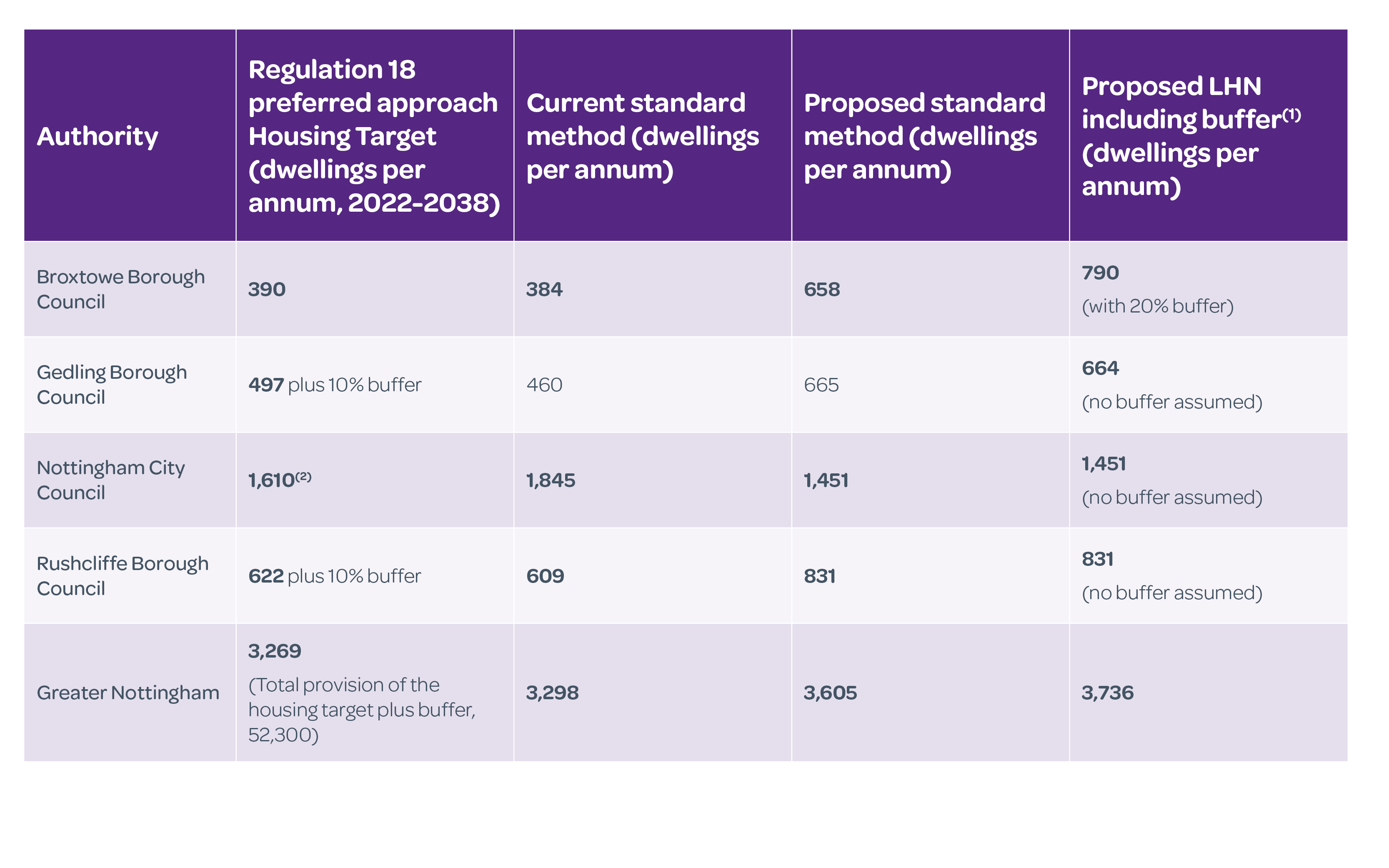Comment
What do the proposed planning reforms mean for the East Midlands?
The East Midlands is one of the country’s fastest growing regions and is widely recognised as a powerhouse for the UK economy. The recent proposed planning reforms have set the stage for major and exciting change for this region in years ahead, with potential opportunities emerging from almost every angle. Our East Midlands team explore these opportunities and what impact the proposed reforms may have.
Housing
In the context of housing, the proposed standard method changes will lead to a 31.7% increase in Local Housing Need (LHN) over and above the current standard method. This represents a significant increase in the number of homes needed across the region and which will need to be planned for by Local Planning Authorities (LPAs).
The December 2023 NPPF includes a 35% ‘urban uplift’ for the country’s largest cities. In the East Midlands, these include Derby, Leicester and Nottingham. The proposed change to the standard method reverses this additional need and distributes growth across a wider area, so whilst some urban areas will see a drop in their LHN, the majority of other areas will see an increase in housing numbers. The changes to the standard method will have an impact on some of the draft local plans currently being prepared (see draft transitional arrangements at Annex 1 of the consultation NPPF), and in some cases it will have quite significant implications for five-year supply positions and speculative applications.
A case study – Greater Nottingham Strategic Plan
To illustrate the potential impact of the proposed standard method on plan making, we have been reflecting on the draft Greater Nottingham Strategic Plan (GNSP) as an example. The plan is being prepared by the Greater Nottingham Planning Partnership, comprising Broxtowe Borough, Gedling Borough, Rushcliffe Borough and Nottingham City Councils. The Regulation 18 consultation in early 2023 set out a preferred approach, including a housing provision that could not meet the 35% uplift for Nottingham City in full, due in part to Green Belt constraints. The table below sets out how the proposed standard method will impact the LHN requirement for each of the Greater Nottingham Planning Partnership authorities.

This indicates that the housing currently proposed by the GNSP is some 336 dwellings per annum below the proposed standard method (or 467 dpa short if the relevant buffers are applied). The transitional arrangements at Annex 1 of the consultation NPPF suggest that the GNSP would instead need to be prepared against the emerging NPPF and its higher LHN, given the current draft GNSP is more than 200 dpa short of the figure set through the proposed standard method.
A Regulation 19 consultation on the GNSP was expected around September 2024. A delay is now inevitable. If the GNSP does need to be prepared under the new NPPF, it would need to consider:
- An increased housing need: 10.3% above the GNSP Regulation 18 (14.3% with a buffer).
- An increased emphasis on addressing strategic matters, including the requirement to accommodate unmet needs and continuation of the legal Duty to Cooperate (paragraph 27).
- A need to find sites to meet needs for commercial development that meets the need of a modern economy (paragraph 84).
- The need to review Green Belt boundaries where necessary to deliver the housing, commercial or other development needs (paragraph 142); with a priority for brownfield / grey belt land in sustainable locations (paragraph 144). This includes ‘golden rules’ such as the provision of 50% affordable housing (paragraph 155).
The example of the GNSP illustrates how significant the proposed changes to the NPPF will be to establishing housing need, planning for housing growth and plan making. Notwithstanding these significant opportunities, this is clearly not going to be straightforward and will likely result in delays to some local plans in the short term.
The economy
The Written Ministerial Statement (WMS) is clear that ‘sustained economic growth is the only route to improving the prosperity of our country and the living standards of working people’ and sets out the importance of economic growth alongside housing. Particular reference is made to ‘support those sectors which will be the engine of the UK’s economy’. These are identified as being ‘laboratories, gigafactories, data centres, electricity grid connections and the networks that support freight and logistics’. This follows through into the changes being sought in the NPPF (at paragraph 84b) which makes specific reference to planning policies identifying suitable locations for development which supports a ‘modern economy’.
Benefitting from the East Midlands Airport (the UK’s largest cargo airport), East Midlands Freeport (the only inland Freeport), two Enterprise Zones supporting automotive technology and a space cluster, and excellent air, rail and road connections, the East Midlands is well positioned to meet the Government’s aspiration for ‘sustained economic growth’ and to meet the needs of a ‘modern economy’.
The focus of the NPPF’s amendments and support for developments within the knowledge and innovation sector link well with the East Midlands existing, varied and fast-growing economy. The changes will facilitate local authorities to give greater emphasis, support, and a clear strategy within planning policy on how the East Midlands can develop and expand its advanced manufacturing, automotive technology, space cluster, and freight economy.
Strategic planning
The expectation is that Local Authorities will make every effort to allocate land in line with their housing need calculated by the new standard method and will need to demonstrate that they have done so at examination of their plan. However, in the written ministerial statement published on the 30 July, Angela Rayner states the need to plan for growth on a larger scale. The NPPF consultation emphasises the importance of continued collaboration between LPAs in accordance with the Duty to Cooperate on key cross boundary issues, including strategic infrastructure and unmet housing needs.
In the longer term, the Government will introduce effective new mechanisms for cross-boundary strategic planning to deliver sustainable growth and address key spatial issues. There will be a key role for elected Mayors to oversee the development and agreement of Spatial Development Strategies (SDS) for their area, this follows the announcement of the English Devolution Bill in the King’s Speech in July. The Bill is tipped to grant new powers to regional mayors with the aim of driving forward significant economic growth.
In the coming years, we may see an SDS covering Derbyshire, Derby City, Nottingham City and Nottinghamshire, led by the East Midlands Combined County Authority Mayor, who will, in turn, likely benefit from increased powers to bring key stakeholders together to address strategic matters. There is great opportunity for this to turbo charge growth in the region, but to enable a truly joined up approach, the Combined County Authority Mayor will need to work closely with other Mayors in the East Midlands.
There will no doubt be many challenges in the months and years ahead. But what is clear is that the proposed amendments to the NPPF, and the wider shifting political landscape, present a significant opportunity for the East Midlands region, which is well placed to drive forward sustainable economic and housing growth in the heart of the UK.
For more information on how the proposed planning reforms will impact the East Midlands, and the opportunities presented, please contact a member of our East Midlands team.
15 August 2024
[1] Based on draft NPPF paragraph 76 and the Average Annual Net Additions (2020/21 – 2022/23) published alongside the proposed standard method. Whether a buffer is required will depend on the results of the Housing Delivery Test
[2] This figure is lower than the current standard method as the GNSP has removed the element of the city council’s housing need that cannot be met within its boundaries


